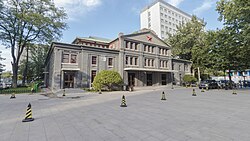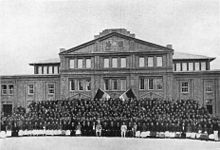The National Assembly Building (北京国会旧址) is the first purpose-built meeting place of the National Assembly (國會, Guóhuì) of the Republic of China in Beijing. It was designed by Curt Rothkegel (1876-1945), a German architect based in Qingdao. Rothkegel had made earlier (and grander) designs for a Parliament Building commissioned by the late Qing Dynasty, whose construction was started in 1910 on the site of today's Beijing International Hotel on East Chang'an Avenue, but was left unfinished at the time of the Xinhai Revolution in 1911.[1] The building was used intermittently for sessions of the National Assembly during its troubled history from the aftermath of China's first national election to the Beijing Coup in October 1924.
| National Assembly Building | |
|---|---|
北京國會舊址 | |
 The building on Xinhua News Agency campus | |
 | |
| General information | |
| Town or city | Beijing |
| Country | China |
| Completed | 1913 |
| Design and construction | |
| Architect(s) | Curt Rothkegel |
The National Assembly Building is now part of the compound of Xinhua News Agency in central Beijing. Xinhua restored it and uses it for events. The Xinhua History Exhibition Hall, an in-house museum, is located in nearby Republican-era brick buildings. The National Assembly building is not open to the public.

References
edit- ^ Sang Ye; Geremie R. Barmé (June 2008). "A Beijing That Isn't (Part I)". China Heritage Quarterly.
See also
edit